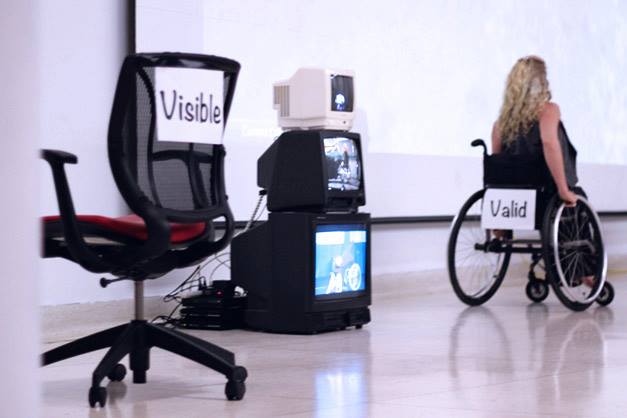
I originally wrote this as a speech for Toastmasters this past summer. I remembered it today and thought it would make a blog post.
What are your thoughts on the inclusive design and Ontario’s economy?
The changing economy of Ontario is an exciting place to be today. We have unique opportunities to impact the lives of many, including persons with disabilities. Inclusive design may seem like a challenging and a poor use of resources. However, it can powerfully impact Ontario’s economy and give it the push it needs to gain power on the international stage.
There are three main reason that businesses and organizations in Ontario will benefit from inclusive design. First, Ontario’s consumers are growing older, and inclusive design will help businesses meet the needs of its changing demographic. Secondly, inclusive design encourages more creative and innovative problem-solving which will add value to products and services. Third, the cost of exclusion is higher than inclusion and will save Ontario business owners and organizations money in the long run.
Ontario’s consumers are growing older.
The face of Ontario is changing. The workers, residents, and consumers of the province are growing older. We all become disabled in some way sooner or later, thus it is important that products, services, and environments can continue to meet the needs of it consumers, or else a huge market is left ignored. Inclusive design can accelerate Ontario’s economic growth by reaching a market the size of China- the international disability market. A market that large cannot be ignored by Ontario businesses.
Our population is not getting younger. Catering to the disability consumer market will help Ontario become an international leader in social and human centred design.
Inclusive design encourages more creative and innovative problem solving which will add value to products and services.
In reality, no-one wants design for all; everyone wants design for me. Whether its something as personal as the organization of applications on your dock or desktop, or the features of a new car or home, we all want something unique to ourselves. Ontario businesses need to offer the ability to customize a product to meet an individual’s needs and wants- and especially the flexibility of the digital world can allow us that freedom.
Inclusive design adds value to a product- just think of Siri on your iPhone, the TTC stop announcements, or closed captioning on the TV when you’re at the gym or a noisy bar. It adds value. For example, Nestle improved their packaging so that people with arthritis could open their coffee containers with ease. Although the new packaging had a higher consumer price tag, it improved sales.
When a product or service is easier to use and access, it increases consumption. Ontario needs higher consumption of its goods and services. It is good for the economy. When these things are made easier to use and to access, Ontario will thrive.
The cost of exclusion is higher than the cost of inclusion.
When the available goods and services do not meet the needs and wants of its residences, there are long-term social and economic challenges. Social problems lead to an unhealthy society as a whole. Studies have shown that more equal societies do better on many measures of social health and wealth, improving the quality of life for all residences. A unhealthy society becomes a cash drain on the province and businesses.
Think of the workplace as an example. Poorly designed work environments cause stress, and stress creates disabilities. Well designed workspaces and equipment increase employee productivity, which increases Ontario’s gross domestic product (GDP).
Additionally, it is estimated that increased workforce participation among people with disabilities will increase the GDP per capita in Ontario by $600 per annum. The Prosperity and Economic Progress report of 2009 stated that Ontario is not as productive as its competitors. With Ontario’s shrinking labour pool, the province cannot afford to loose further productivity.
Ontario needs inclusive design.
As a young professional, those are some of my thoughts and research on how inclusive design can help save Ontario’s economy. The reality that Ontario’s consumers are growing older, that innovative problem solving adds value to goods and services, and the high cost of exclusion are three of some of the reasons that businesses and organizations will benefit from inclusive design. We as a province cannot afford to merely catch up to our competitors. Instead, Ontario needs to build for the future.
Resources
Donovan, R. Lecture. Inclusive Design Summer Intensive. OCAD University, Toronto.17 July 2012.
Donovan, R. “Mining the disability market.” BBC. (2011). Web. 29 April 2013.
Hassell, J. “Beyond Inclusion and Reverse Inclusion: how fully engaging with the needs of disabled and elderly people can turbo-charge innovation and profitability.” Hassell Inclusion. (2012). Web. 29 April 2013.
Henry, S., Arch A., Brewer , J. “Developing a Web Accessibility Business Case for Your Organization.” W3C. (2012). Web. 29 April 2013.
Kemper et al. Releasing Constraints: Projecting the Economic Impacts of Increased Accessibility in Ontario. Martin Prosperity Institute. (2010). PDF. Web. 29 April 2013.
Smith, K. “What We Can Learn from Digital Outcasts.” Accessibility and Inclusive Design Meetup Group Toronto. Devlin, Toronto. 29 May 2013.
Treviranus, J. Lecture. Inclusive Design Summer Intensive. OCAD University, Toronto. 18 July 2012.
Wilkinson, R. G. (2009). The Spirit Level: Why More Equal Societies Almost Always Do Better. London: Allen Lane. Print.

